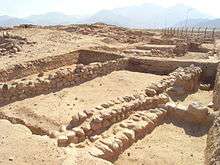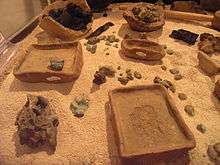Tall Hujayrat Al-Ghuzlan


Tall Hujayrat Al-Ghuzlan is an archaeological site during the Chalcolithic period that lies 4 km north of modern-day Aqaba city in Jordan. Tall Hujayrat Al-Ghuzlan and the neighboring Tall Al-Magass site in Aqaba both have extensive evidence of significant copper production and trade in the region.[1]
Overview
Archaeologists from University of Jordan discovered the site. They found a building whose walls were inscribed with human and animal drawings which suggested that the building was used as a religious site. The people who inhabited the site had developed an extensive water system for irrigating their crops (mostly grapes and wheat). Searchers also uncovered several different-sized clay pots, suggesting that copper production was a major industry in the region (the pots were possibly used in melting the copper and reshaping it). Scientific studies performed onsite revealed that it had undergone two earthquakes, with the latter one leaving the site completely destroyed.[2]
References
- ↑ Klimscha, Florian. "Long-range Contacts in the Late Chalcolithic of the Southern Levant. Excavations at Tall Hujayrat al-Ghuzlan and Tall al-Magass_near Aqaba, Jordan". academia.edu.
- ↑ "اكتشافات أثرية في موقع حجيرة الغزلان بوادي اليتيم في جنوب الأردن". جريدة الشرق الأوسط. H. H. Saudi Research and Marketing Ltd. 24 April 2004. Retrieved 27 September 2015.
Coordinates: 29°33′59″N 35°02′03″E / 29.5663°N 35.0341°E